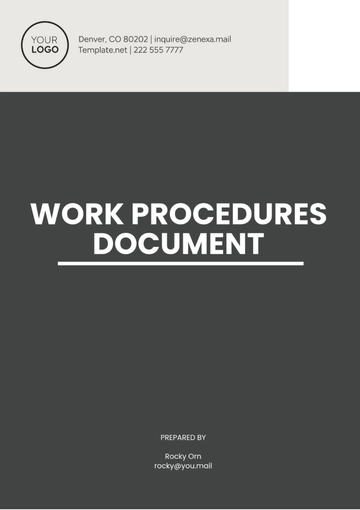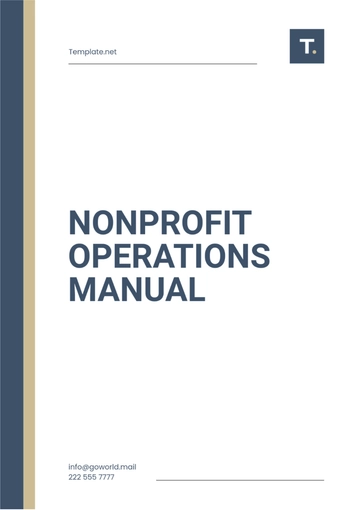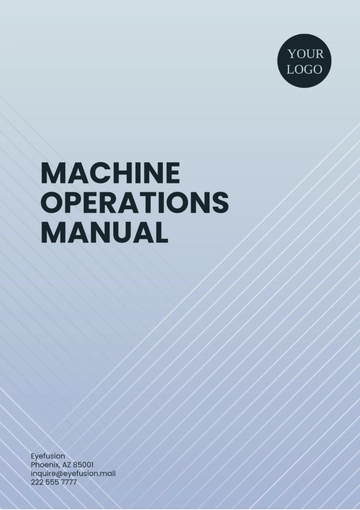Free Bakery Production Manual

I. Introduction
A. Purpose
Guidance: This Bakery Production Manual provides comprehensive guidelines for the bakery production process to ensure consistency and quality in every batch of products.
Standards: It establishes the standards for production, safety, and quality control that all staff members must follow.
Efficiency: This manual aims to streamline production processes, reducing waste and increasing efficiency.
B. Scope
Production Process: This manual covers all aspects of bakery production, including ingredient selection, mixing, baking, and packaging.
Quality Control: It includes guidelines for maintaining product quality and consistency.
Safety Procedures: This manual outlines safety procedures to protect staff and ensure a safe working environment.
C. Target Audience
Bakery Staff: All employees involved in the production of baked goods at [Your Company Name].
Quality Control Team: Staff responsible for overseeing product quality and safety.
Management: Supervisors and managers who oversee bakery operations and ensure compliance with the guidelines.
II. Ingredients Selection
The following table provides an overview of the steps involved in the ingredients selection process. Each step is critical to ensure the highest quality of baked goods.
No. | Step | Description |
|---|---|---|
1 | Sourcing Ingredients | Selecting the best suppliers for quality ingredients. |
2 | Inspecting Deliveries | Checking the quality and freshness of delivered items. |
3 | Storing Ingredients | Proper storage to maintain quality and prevent spoilage. |
A. Sourcing Ingredients
Supplier Selection: Choose suppliers known for high-quality ingredients. Establish long-term relationships with trusted vendors.
Quality Standards: Set quality standards for all ingredients, ensuring they meet our bakery’s requirements.
Regular Audits: Conduct regular audits of suppliers to ensure ongoing compliance with quality standards.
Contract Negotiations: Negotiate contracts to secure the best prices without compromising on quality.
Sustainable Sourcing: Prioritize suppliers who practice sustainable sourcing to support environmental responsibility.
B. Inspecting Deliveries
Arrival Inspection: Inspect all deliveries immediately upon arrival for freshness and quality.
Documenting Issues: Document any issues with deliveries and report them to the supplier for resolution.
Sampling: Take samples from each batch of ingredients to test for quality.
Storage Preparation: Prepare ingredients for storage according to their specific requirements.
C. Storing Ingredients
Temperature Control: Store ingredients at the correct temperatures to maintain freshness.
Labeling: Label all stored ingredients with the date of delivery and expiration date.
FIFO Method: Use the First In, First Out (FIFO) method to rotate stock and prevent spoilage.
Regular Checks: Conduct regular checks of stored ingredients to ensure they remain in good condition.
Clean Storage Areas: Keep storage areas clean and free from contaminants.
Selecting the right ingredients and ensuring they are of the highest quality is the foundation of producing exceptional baked goods. Proper sourcing, inspection, and storage not only preserve the integrity of the ingredients but also contribute to the overall efficiency and effectiveness of the production process. Each staff member plays a vital role in this chain, ensuring that from the moment ingredients arrive to the final product, quality is maintained at every step.
III. Mixing and Preparation
The following table outlines the key steps involved in the mixing and preparation process. Proper execution of these steps is essential for achieving the desired consistency and flavor of our baked goods.
No. | Step | Description |
|---|---|---|
1 | Measuring Ingredients | Accurately measuring all ingredients according to recipes. |
2 | Mixing Techniques | Using appropriate mixing techniques for different doughs. |
3 | Resting and Proofing | Allowing dough to rest and proof for optimal texture. |
A. Measuring Ingredients
Accuracy: Use precise measuring tools to ensure the correct quantities of ingredients.
Consistency: Follow standardized recipes to maintain consistency in product quality.
Record Keeping: Keep records of ingredient quantities used for each batch.
Scaling Recipes: Scale recipes accurately for different batch sizes.
Training: Train staff on proper measuring techniques to avoid errors.
B. Mixing Techniques
Equipment Selection: Use the appropriate mixing equipment for different types of dough.
Mixing Times: Follow specific mixing times for each recipe to achieve the desired texture.
Speed Settings: Adjust mixer speeds according to the type of dough being prepared.
Ingredient Order: Add ingredients in the correct order to ensure proper incorporation.
C. Resting and Proofing
Rest Periods: Allow dough to rest for the specified periods to develop flavor and texture.
Proofing Conditions: Maintain the correct temperature and humidity levels during proofing.
Timing: Monitor proofing times closely to avoid over-proofing or under-proofing.
Handling: Handle dough gently to preserve air bubbles and achieve a light texture.
Inspection: Regularly inspect proofed dough for signs of readiness before proceeding to baking.
Mixing and preparation are critical stages in the production process that significantly impact the final product. Accurate measuring ensures that each batch is consistent and meets quality standards. Proper mixing techniques are vital for developing the right texture and structure in the dough, which directly affects the quality of the baked goods. Resting and proofing allow the dough to develop its flavors and achieve the desired texture. Staff training and adherence to standardized recipes and procedures are essential for maintaining consistency and quality.
IV. Baking
The following table provides an overview of the baking process. Each step must be executed with precision to ensure the best possible outcome for our baked goods.
No. | Step | Description |
|---|---|---|
1 | Preheating Ovens | Ensuring ovens are preheated to the correct temperature. |
2 | Baking Times and Temperatures | Following specific baking times and temperatures for each product. |
3 | Monitoring and Adjustments | Regularly checking products and making necessary adjustments. |
A. Preheating Ovens
Temperature Settings: Set ovens to the correct temperature as specified in the recipe.
Timing: Allow sufficient time for ovens to reach the desired temperature before baking.
Verification: Use oven thermometers to verify the accuracy of temperature settings.
Consistency: Maintain consistent oven temperatures to ensure even baking.
Oven Maintenance: Regularly maintain ovens to ensure they function properly and efficiently.
B. Baking Times and Temperatures
Recipe Guidelines: Follow the specific baking times and temperatures outlined in recipes.
Batch Sizes: Adjust baking times for different batch sizes as needed.
Uniformity: Ensure uniform placement of products in the oven for even baking.
Rotation: Rotate baking trays or products halfway through the baking time for uniform results.
C. Monitoring and Adjustments
Regular Checks: Regularly check baked goods to monitor progress and prevent over or under-baking.
Temperature Adjustments: Adjust oven temperatures if necessary based on observations.
Baking Tools: Use appropriate tools, such as baking stones or steam injectors, to achieve desired results.
Product Inspection: Inspect finished products for quality, ensuring they meet our standards.
The baking process is where the dough transforms into the final product, and precision at this stage is crucial. Preheating ovens to the correct temperature ensures that the baking process starts correctly and helps achieve consistent results. Adhering to specified baking times and temperatures is essential for producing baked goods with the desired texture, flavor, and appearance. Monitoring the baking process allows for necessary adjustments, ensuring that each product is baked to perfection. Proper oven maintenance and staff training on baking techniques are vital for maintaining the quality and consistency of our products.
V. Cooling and Packaging
Proper cooling and packaging are essential to maintain the quality and freshness of our baked goods. The following table outlines the key steps involved in the cooling and packaging process:
No. | Step | Description |
|---|---|---|
1 | Cooling | Allowing baked goods to cool to the correct temperature. |
2 | Inspection | Inspecting products for quality before packaging. |
3 | Packaging | Using appropriate packaging materials to maintain freshness. |
A. Cooling
Cooling Racks: Place baked goods on cooling racks to allow even air circulation.
Timing: Allow sufficient cooling time to reach the appropriate temperature.
Temperature Monitoring: Monitor the temperature of baked goods to ensure proper cooling.
Handling: Handle baked goods carefully during the cooling process to avoid damage.
Environment: Maintain a clean and controlled environment in the cooling area.
B. Inspection
Visual Check: Inspect products visually for any defects or irregularities.
Quality Standards: Ensure products meet our quality standards before packaging.
Sampling: Take samples for quality testing to confirm consistency.
Record Keeping: Document inspection results for quality control purposes.
C. Packaging
Packaging Materials: Use appropriate packaging materials to maintain product freshness and quality.
Labeling: Label packages with product information, including the production date and expiration date.
Sealing: Ensure packaging is properly sealed to prevent contamination and maintain freshness.
Storage: Store packaged products in the appropriate conditions to extend shelf life.
Inventory Management: Maintain an organized inventory system for packaged products.
Cooling and packaging are the final steps in the production process, and they are critical for preserving the quality and freshness of our baked goods. Proper cooling allows products to reach the optimal temperature before packaging, ensuring they retain their texture and flavor. Thorough inspection ensures that only products meeting our quality standards are packaged and sent to customers. Using the right packaging materials and techniques is essential for maintaining freshness and preventing contamination.
VI. Quality Control
The following table provides an overview of the quality control process. Each step is essential to ensure that our products meet the highest standards of quality and safety.
No. | Step | Description |
|---|---|---|
1 | Ingredient Testing | Testing ingredients for quality and safety before use. |
2 | Process Monitoring | Monitoring each stage of production for adherence to standards. |
3 | Finished Product Testing | Testing finished products for quality and safety. |
A. Ingredient Testing
Sampling: Regularly sample ingredients to test for quality and safety.
Lab Testing: Send samples to a certified lab for comprehensive testing.
Supplier Audits: Conduct regular audits of suppliers to ensure ongoing compliance with quality standards.
Documentation: Keep detailed records of all ingredient testing results.
Compliance: Ensure all ingredients comply with regulatory and safety standards.
B. Process Monitoring
Checklists: Use standardized checklists to monitor each stage of production.
Training: Train staff on quality control procedures and the importance of adherence.
Real-Time Monitoring: Implement real-time monitoring systems to track production processes.
Feedback: Collect feedback from staff to identify and address potential issues.
Continuous Improvement: Continuously review and improve quality control procedures based on feedback and testing results.
C. Finished Product Testing
Visual Inspection: Conduct visual inspections of finished products for defects.
Taste Testing: Regularly taste test products to ensure flavor and texture meet standards.
Shelf Life Testing: Test the shelf life of products to ensure they remain fresh for the intended period.
Customer Feedback: Collect and analyze customer feedback to identify areas for improvement.
Record Keeping: Document all testing results and use them to improve future production processes.
Quality control is an integral part of our bakery production process, ensuring that every product we produce meets the highest standards of quality and safety. Ingredient testing ensures that we start with the best possible components, while process monitoring helps maintain consistency and identify potential issues early. Finished product testing guarantees that the final products are of the highest quality before they reach our customers. By implementing rigorous quality control procedures and continuously improving them based on feedback and testing results, we can maintain our reputation for excellence and ensure customer satisfaction.
VII. Safety Procedures
The following table provides an overview of the safety procedures that must be followed to ensure a safe working environment for all staff members:
No. | Component | Description |
|---|---|---|
1 | Personal Protective Equipment (PPE) | Ensuring all staff wear the appropriate PPE. |
2 | Equipment Safety | Proper use and maintenance of bakery equipment. |
3 | Emergency Procedures | Knowing and following emergency procedures. |
A. Personal Protective Equipment (PPE)
Types of PPE: Ensure staff wear the appropriate PPE, including gloves, aprons, and hairnets.
Training: Train staff on the proper use and care of PPE.
Compliance: Regularly check for compliance with PPE guidelines.
Availability: Ensure an adequate supply of PPE is always available.
Replacement: Replace damaged or worn PPE promptly.
B. Equipment Safety
Training: Provide comprehensive training on the safe use of all bakery equipment.
Maintenance: Regularly maintain and inspect equipment to ensure it is in good working condition.
Operating Procedures: Follow standardized operating procedures for each piece of equipment.
Safety Features: Ensure all safety features on equipment are functional and used correctly.
C. Emergency Procedures
Evacuation Plans: Ensure all staff are familiar with evacuation plans and routes.
Fire Safety: Train staff on fire safety procedures and the use of fire extinguishers.
First Aid: Provide first aid training and ensure first aid kits are accessible.
Incident Reporting: Implement a system for reporting and investigating safety incidents.
Regular Drills: Conduct regular safety drills to ensure staff are prepared for emergencies.
Safety procedures are essential to protect the health and well-being of all staff members and to ensure a safe working environment. Personal protective equipment (PPE) is a critical component of workplace safety, helping to prevent injuries and contamination. Proper training and maintenance of bakery equipment reduce the risk of accidents and ensure efficient operation. Emergency procedures prepare staff to respond effectively in the event of an incident, minimizing harm and disruption. By adhering to these safety procedures, we can create a safe and productive workplace where staff can focus on producing high-quality baked goods.
VIII. Cleaning and Maintenance
Proper cleaning and maintenance are essential to ensure a hygienic and efficient bakery operation. The following table outlines the key components in the cleaning and maintenance process:
No. | Component | Description |
|---|---|---|
1 | Daily Cleaning | Performing daily cleaning tasks to maintain hygiene. |
2 | Weekly Cleaning | Conducting more thorough weekly cleaning tasks. |
3 | Equipment Maintenance | Regular maintenance and inspection of all equipment. |
A. Daily Cleaning
Surfaces: Clean all surfaces, including worktops and equipment, at the end of each shift.
Floors: Sweep and mop floors daily to prevent the buildup of dirt and debris.
Trash Disposal: Empty trash bins and dispose of waste properly.
Sanitization: Sanitize high-touch areas, such as door handles and switches, regularly.
Documentation: Record all daily cleaning tasks in a cleaning log for accountability.
B. Weekly Cleaning
Deep Cleaning: Perform deep cleaning of all areas, including under equipment and storage areas.
Equipment: Disassemble and thoroughly clean equipment to remove any buildup.
Pest Control: Check for signs of pests and take appropriate action if necessary.
Inventory: Inspect and clean storage areas, ensuring proper rotation of stock.
Verification: Have a supervisor verify that all weekly cleaning tasks are completed.
C. Equipment Maintenance
Inspection: Regularly inspect all equipment for signs of wear and damage.
Repairs: Promptly repair or replace any damaged equipment.
Lubrication: Lubricate moving parts of equipment as per manufacturer’s recommendations.
Calibration: Calibrate equipment regularly to ensure accuracy and efficiency.
Maintenance Records: Keep detailed records of all maintenance activities for reference.
Cleaning and maintenance are vital for maintaining a hygienic and efficient bakery operation. Daily cleaning tasks help to prevent the buildup of dirt and bacteria, ensuring a clean environment for food production. Weekly deep cleaning tasks address areas that require more thorough attention and help to maintain a high standard of cleanliness. Regular equipment maintenance reduces the risk of breakdowns and ensures that all machinery operates efficiently. By following these cleaning and maintenance procedures, we can create a safe and hygienic workplace that supports the production of high-quality baked goods.
IX. Frequently Asked Questions (FAQs)
Q: How do I know if my dough is properly proofed?
A: Properly proofed dough should have doubled in size and feel light and airy. You can also perform the "poke test" – gently press a finger into the dough; if it springs back slowly, it is ready.
Q: What should I do if I notice a problem with the oven temperature?
A: If you notice an issue with the oven temperature, stop production and report the problem to a supervisor immediately. Use an oven thermometer to check for accuracy and make necessary adjustments.
Q: How often should I clean the equipment?
A: Equipment should be cleaned daily after each shift and thoroughly deep cleaned weekly. Regular maintenance and inspections should also be conducted to ensure proper functioning.
Q: What PPE is required in the bakery?
A: Staff must wear gloves, aprons, and hairnets at all times. Additional PPE, such as face masks or safety goggles, may be required depending on specific tasks and safety guidelines.
Q: How can I ensure consistent product quality?
A: Follow standardized recipes and procedures, accurately measure ingredients, and monitor each stage of production. Regular quality control checks and staff training are also essential for maintaining consistency.
Q: What are the emergency procedures in the bakery?
A: Familiarize yourself with the evacuation plans and fire safety procedures. In case of an emergency, follow the established protocols and report any incidents to a supervisor immediately.
Q: How should I handle customer feedback?
A: Collect and document all customer feedback, both positive and negative. Use the feedback to identify areas for improvement and implement changes to enhance product quality and customer satisfaction.
Q: How do I ensure proper cooling and packaging of products?
A: Allow products to cool completely before packaging to prevent condensation and spoilage. Use appropriate packaging materials and label packages with product information, including the production date and expiration date.
- 100% Customizable, free editor
- Access 1 Million+ Templates, photo’s & graphics
- Download or share as a template
- Click and replace photos, graphics, text, backgrounds
- Resize, crop, AI write & more
- Access advanced editor
Streamline production processes with ease with the Bakery Production Manual Template! This editable and customizable template from Template.net provides a comprehensive guide to your bakery's production operations. The AI Editor Tool enables you to easily adapt the manual to reflect your unique production workflows, helping you maintain consistency and efficiency!





























